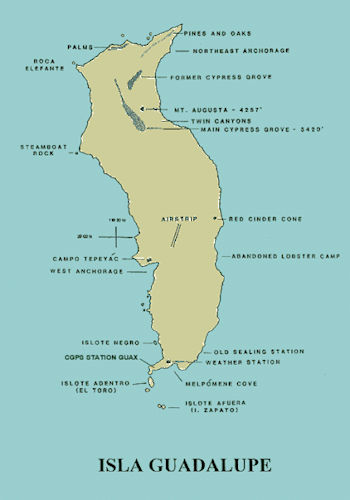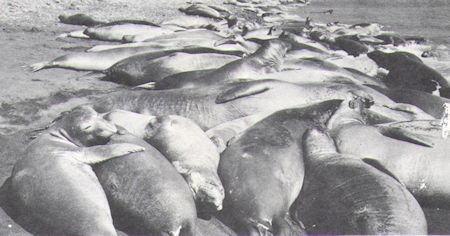 |  |
By Greg Niemann

Guadalupe Island (Isla Guadalupe), a Mexican Island belonging to the State of Baja California, has attracted all types of adventurers throughout the years. Visitors drawn to the 80-square-mile lava-capped island have included Russian and native Alaskan seal hunters, Chinese oyster fishermen, American seamen, and many others.
The total area of Guadalupe is just a little larger than Southern California’s Catalina Island, but Guadalupe rises from sea level to an astonishing elevation of more than 4,000 feet! Two volcanoes, Mount Augusta at 4,259 feet and El Picacho at 3,199 feet, make up the island’s tallest mountains. Although rocky, there is still vegetation, including a grove of about 4,000 Cypress trees on the north end.
Guadalupe Island and its islets form not only the westernmost region of Mexico, but the westernmost point in all of Latin America. Guadalupe is about 400 kilometers southwest of its Municipal capital, Ensenada.
There are several campos on the island, and it is currently home to fewer than 150 permanent residents, mostly abalone and lobster fishermen. The number of residents varies annually depending on the fishing season. Ten months of the year the 30 families of the fishing cooperative “Abuloneros and Langosteros of Guadalupe Island” are present.
The remote island is an inhospitable destination place as strong winds and large ocean swells are constant during the winter months. Generators provide electricity, and a military vessel brings fresh water to the inhabitants on a regular basis. There is a weather station staffed by a detachment from the Mexican Ministry of the Navy at the southern tip of Guadalupe.
Sited by Vizcaino in 1602

The first known sighting of Guadalupe Island was in 1602 when a Spanish expedition headed by Sebastián Vizcaíno sailed by but did not land on the island. From the late 18th and through the 19th centuries the island was frequently visited by fur seal, otter, and elephant seal hunters.
Today it’s generally adventurous Americans who go to Guadalupe for sport fishing, but many of those early visitors had agendas that almost destroyed the animal populations and native habitat.
Hunters came to Guadalupe from around the world. The Russians, after decimating vast populations of sea otters from northern waters, sent Aleut hunters south from Alaska seeking the California fur seals. They virtually wiped out the fur seal population along the way, eventually ending up at Guadalupe Island.
Shortly after the turn of the 19th century American vessels were harvesting fur seals at Guadalupe Island. Captain Charles Scammon, who was known for slaughtering much of the California gray whale population, also joined in and killed many elephant seals, even writing about it in “Overland Monthly.”
The Americans were joined by seamen from other countries and unhampered for years, the slaughter of fur seals went on and on, without any regard toward the annihilation of the species.

Chinese in their junks who went to Guadalupe to harvest oysters also got into the act, taking many fur seals there. The many caves and nooks and crannies around rocky Guadalupe Island saved the fur seals from total extinction. A small colony was finally spotted there in 1926-27 and two bulls were taken for the San Diego Zoo.
The northern elephant seal was also ruthlessly hunted for its blubber the oil and thought to be universally extinct by 1884. However, on Guadalupe in 1892, a Smithsonian expedition discovered eight individual elephant seals which allowed the species to survive. They were finally protected by the Mexican government in 1922 when President Alvaro Obregon banned the killing and molesting of elephant seals and declared the island a reservation.
Feral goats destroy habitat
In the 1800s many Europeans, when stopping over for provisions, introduced goats to the island. The goats quickly increased their numbers, nearly eradicating the indigenous vegetation. At one time there were up to 100,000 feral goats there, all descending from the original goats brought to the island.
Naturalist Alfred Webster Anthony, (1865-1939), one of the early directors of the San Diego Natural History Museum, had visited Guadalupe Island three times. In his 1901 summary he lamented: “It is directly due to the despised Billy-goat that many interesting species of plants formerly abundant are now extinct, and also that one or more of the birds peculiar to the island has disappeared, and others are following rapidly.”

In 1839 the Mexican government sold Guadalupe Island and the smaller islets of Rocas Alijos, hundreds of miles to the south, to two Mexican businessmen, José Castro and Florencio Ferrano. They gained exclusive rights to hunting seals and goats and pretty much did what they wanted. The two made quite a lucrative business selling goat meat and hides to the Mexican mainland and with passing ships.
Ferrano left by the late 1840s, and in 1860 José Castro sold off his share to Feliciano Ruiz de Esparza. In 1887 it was owned by the Mexican International Company, which later abandoned the island to the remaining goats. In 1910 Alfred Marcuson of Los Angeles received a concession to take the goats off the island. He wasn’t entirely successful.
The goat population eventually eliminated most vegetation before the number of feral goats finally declined to a few thousand. Before this weaning, the main impact of the feral goat population was about the turn of the 19th/20th century.
Afterwards, the feral goat population once again grew, this time more slowly, yet today there are still many goats on Guadalupe Island.
The island has been a nature conservancy area since August 16, 1928, making it one of the oldest reserves in Mexico.
Almost a century later, in 2005, Guadalupe Island and surrounding waters were declared a Biosphere Reserve to restore its vegetation that had been decimated by the goats. The declaration also extended to the protection of its population of marine mammals and birds.
Feral goat fences were installed beginning in 2000, allowing new seedlings of many species to survive for the first time in 150 years.
The Mexican government initiated special permits for anglers and boats to fish the island. Because Guadalupe Island is located within a biosphere reserve, anyone visiting the island today must obtain a permit from the Mexican government; this means the communities on the island are closed towns.
Long-range fishing fleets
Today’s Guadalupe Island visitors are mostly fishing fleets based in San Diego who regularly make the island a destination long-range fishing trip. It’s been popular due to its remote location (an 18-20 hour boat ride), spectacular scenery, and legendary fishing.

The waters around Guadalupe today offer some of the world’s best yellowfin tuna fishing. In recent years the yellowfin population has not only grown in numbers, but reportedly in average size. Yellowfins in the 120-pound range are not uncommon. Recent (2024) fishing reports from the island reported yellowfin tuna in the 70-100 pound range, and yellowtail in the 20-pound class.
Being about 220 miles from San Diego, Guadalupe Island is reached through several Point Loma Sportfishing fleets that currently offer long-range trips (over 5 days), including: H&M Landing, Searcher Sportfishing, Vagabond, and Shogun. Most of the long-range trips are on vessels that can accommodate 25-40 bunks for anglers.
Many long-range trips are provided through the estimable H&M Landings (Since 1935) and its fleet of about two dozen vessels, all individually owned and operated. They offer packages from 2 to 21 days. The trips include live-aboard accommodations, meals, personal crew attention, live bait, on-board fish filleting, and refrigerated fish holds to preserve catches.
Searcher Sportfishing’s 95-foot-long fishing vessel Searcher is one example of a long-range ship. It has 14 cabins that sleep two or three anglers each and have storage shelves, sink, mirror, and a 110-volt AC outlet. Each bunk has sheets, blankets, and pillows. There are four restrooms, two showers, and a large indoor dining salon. The boat is air-conditioned throughout.
Along with super-sized yellowtail and hot yellowfin tuna action, Guadalupe Island is also a favorite feeding ground for great white sharks, and they are often extant. One long-range operator even commented, “Just as you think you’ve got a keeper, they’ll snatch your yellowfin right out from under you. If they see a lot of great whites in the area, your captain might decide to switch fishing spots.”
These days the fur seal, otter, and elephant seal hunters are gone. They have been replaced by anxious sports fishers who eagerly await the awakening yell, “Fish on.” While all onboard scurry to join the action, the remaining goats on the bluffs above continue to munch away at the remaining vegetation.

Great insurance for your motor trip to Mexico.

An inexpensive peace of mind for quick trips to TJ!

In 2010 I met the owner at overland expo and I was so impressed. I even put his bumper sticker on...